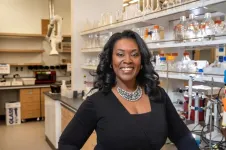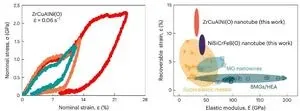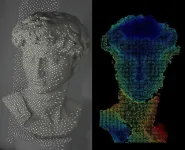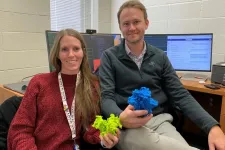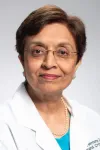(Press-News.org) With a $300,000 grant, the Welch Foundation is supporting University of Texas at Arlington research into why some types of Mycobacterium tuberculosis (Mtb), the bacteria that causes the lung disease tuberculosis (TB), do not respond to treatments.
Since its founding in 1954, the Houston-based Welch Foundation has contributed to the advancement of chemistry through research grants, departmental programs, endowed chairs and other special projects in Texas.
“As one of the nation’s largest private funding sources for chemical research, it is our job to ensure we support the field in a way that advances the field while changing lives,” said Adam Kuspa, president of the foundation. “TB has an enormous impact on society, and I look forward to seeing how Dr. Kayunta Johnson-Winters’ research can help advance our understanding of this dreaded disease.”
Johnson-Winters, associate professor of chemistry and biochemistry at UTA, is leading the project.
“I’m honored that the Welch Foundation sees the value in supporting our research. TB is a global pandemic that is killing about 1.5 million people per year,” Johnson-Winters said. “An estimated 1.8 billion people—about a quarter of the world’s population—are infected with Mycobacterium tuberculosis. Of those carrying the bacterium, about 10% will become ill with the disease, enabling them to infect others.”
Since TB is caused by a bacterium, it can be treated with antibiotics. Infected individuals must take a combination of antibiotics diligently over six to 12 months to stamp out the infection. Patients who stop taking their medications mid-treatment are more likely to see their infection return, only this time, the infection does not respond to treatments.
This new drug-resistant TB can lead to a new infection in the original patient, who can then spread the disease-resistant TB to other people. Drug-resistant TB is much more difficult to treat, often requiring a regimen of a least five medications over 15 to 24 months.
With this new award, Johnson-Winters will study the enzymes within Mtb to understand why they act differently to certain interventions. The grant will also provide resources for additional purification equipment, columns and chemicals needed to further the research. The funds will also support specialized software that will allow researchers to get a better understanding of what is occurring within the enzymes.
“Once we’ve performed our experiments, we will also prepare a library of the mutations to better understand the mechanism of specific enzymes that are targeted for treatment for those hard-to-treat TB disease cases,” Johnson-Winters said.
END
Welch Foundation supports Johnson-Winters' TB research
Grant helps UTA advance understanding of deadly disease
2024-02-02
ELSE PRESS RELEASES FROM THIS DATE:
A sleeker facial recognition technology tested on Michelangelo’s David
2024-02-02
Many people are familiar with facial recognition systems that unlock smartphones and game systems or allow access to our bank accounts online. But the current technology can require boxy projectors and lenses. Now, researchers report in ACS’ Nano Letters a sleeker 3D surface imaging system with flatter, simplified optics. In proof-of-concept demonstrations, the new system recognized the face of Michelangelo’s David just as well as an existing smartphone system.
3D surface imaging is a common tool used in smartphone facial recognition, as well as in computer vision and autonomous driving. These systems typically consist of a dot projector that contains multiple components: ...
Plant groupings in drylands support ecosystem resilience
2024-02-02
Many complex systems, from microbial communities to mussel beds to drylands, display striking self-organized clusters. According to theoretical models, these groupings play an important role in how an ecosystem works and its ability to respond to environmental changes. A new paper in PNAS focused on the spatial patterns found in drylands offers important empirical evidence validating the models.
Drylands make up 40 percent of the Earth’s landmass and are places where water is the limiting resource for life. They often display a characteristic ...
Scientists see an ultra-fast movement on surface of HIV virus
2024-02-02
DURHAM, N.C. – As the HIV virus glides up outside a human cell to dock and possibly inject its deadly cargo of genetic code, there’s a spectacularly brief moment in which a tiny piece of its surface snaps open to begin the process of infection.
Seeing that structure snap open and shut in mere millionths of a second is giving Duke Human Vaccine Institute (DHVI) investigators a new handle on the surface of the virus that could lead to broadly neutralizing antibodies for an AIDS vaccine. Their findings appear Feb. 2 in Science Advances.
Being able to attach an antibody specifically to ...
Gene editing precisely repairs immune cells
2024-02-02
Some hereditary genetic defects cause an exaggerated immune response that can be fatal. Using the CRISPR-Cas9 gene-editing tool, such defects can be corrected, thus normalizing the immune response, as researchers led by Klaus Rajewsky from the Max Delbrück Center now report in “Science Immunology.”
Familial hemophagocytic lymphohistiocytosis (FHL) is a rare disease of the immune system that usually occurs in infants and young children under the age of 18 months. The condition is severe and has a high mortality rate. It is caused by various gene mutations that prevent cytotoxic T cells from functioning normally. These ...
COPD: The effect of low-dose cadmium, a highly toxic metal, on airway epithelial cells
2024-02-02
BIRMINGHAM, Ala. – Cigarette smoke exposure is associated with the development and severity of chronic obstructive pulmonary disease, or COPD, which is the third leading cause of death worldwide.
Cigarette smoke contains 2 to 3 micrograms of cadmium, a highly toxic metal and environmental pollutant, per cigarette. Burning tobacco releases cadmium oxide that can be adsorbed onto microparticles in smoke that travel deep into the lungs. Furthermore, the body is not able to remove cadmium, which accumulates in longtime smokers.
In ...
Regulation makes crypto markets more efficient
2024-02-02
First-of-its-kind research on cryptocurrency finds that the most regulated coins create the most efficient markets.
That crypto regulation, often provided by cryptocurrency exchanges like Binance, can also help protect investors by providing reliable, public information.
“Both small and institutional investors should know, if they invest in coins without any regulation, they may suffer from price manipulation or a severe lack of insider information,” said Liangfei Qiu, a University of Florida professor of business and one of the authors of the new study.
“Instead, they may want to invest in coins listed with platforms ...
Centuries-old texts penned by early astronomers Copernicus and Sacrobosco find new home at RIT
2024-02-02
The ancient astronomer Nicolaus Copernicus was the first scientist to document the theory that the sun is the center of the universe in his book, De Revolutionibus Orbium Coelestium (On the Revolutions of the Heavenly Spheres). That first edition book, along with a delicate manuscript from astronomer Johannes de Sacrobosco, that is contrary to Copernicus’ groundbreaking theory, has now found a permanent home at Rochester Institute of Technology.
The texts were donated to RIT’s Cary Graphic Arts Collection, one of the world’s premier libraries on graphic communication history and practices. The donor is Irene ...
Mechanism discovered that protects tissue after faulty gene expression
2024-02-02
The genetic material, in the form of DNA, contains the information that is crucial for the correct functioning of every human and animal cell. From this information repository, RNA, an intermediate between DNA and protein, the functional unit of the cell, is generated. During this process, the genetic information must be tailored for specific cell functions. Information that is not needed (introns) is cut out of the RNA and the important components for proteins (exons) are preserved. A team of researchers led by Professor Dr Mirka Uhlirova at the University of Cologne’s CECAD Cluster of ...
Proteins suggest a path to reduce drug resistance in a form of cancer
2024-02-02
RICHLAND, Wash.—Doctors have nearly a dozen new targeted drugs to treat patients with acute myeloid leukemia, or AML, yet three of four patients still die within five years. Some patients succumb within just a month or two, despite the battery of drugs used to treat the aggressive blood disease, where blood cells don’t develop properly.
A new study draws on a field of science known as proteogenomics to try to improve the outlook. In a paper published Jan. 16 in Cell Reports Medicine, scientists report new ...
Unveiling Oxidation-induced Super-elasticity in Metallic Glass Nanotubes
2024-02-02
Oxidation can degrade the properties and functionality of metals. However, a research team co-led by scientists from City University of Hong Kong (CityU) recently found that severely oxidized metallic glass nanotubes can attain an ultrahigh recoverable elastic strain, outperforming most conventional super-elastic metals. They also discovered the physical mechanisms underpinning this super-elasticity. Their discovery implies that oxidation in low-dimension metallic glass can result in unique properties for ...
LAST 30 PRESS RELEASES:
Making lighter work of calculating fluid and heat flow
Normalizing blood sugar can halve heart attack risk
Lowering blood sugar cuts heart attack risk in people with prediabetes
Study links genetic variants to risk of blinding eye disease in premature infants
Non-opioid ‘pain sponge’ therapy halts cartilage degeneration and relieves chronic pain
AI can pick up cultural values by mimicking how kids learn
China’s ecological redlines offer fast track to 30 x 30 global conservation goal
Invisible indoor threats: emerging household contaminants and their growing risks to human health
Adding antibody treatment to chemo boosts outcomes for children with rare cancer
Germline pathogenic variants among women without a history of breast cancer
Tanning beds triple melanoma risk, potentially causing broad DNA damage
Unique bond identified as key to viral infection speed
Indoor tanning makes youthful skin much older on a genetic level
Mouse model sheds new light on the causes and potential solutions to human GI problems linked to muscular dystrophy
The Journal of Nuclear Medicine ahead-of-print tip sheet: December 12, 2025
Smarter tools for peering into the microscopic world
Applications open for funding to conduct research in the Kinsey Institute archives
Global measure underestimates the severity of food insecurity
Child survivors of critical illness are missing out on timely follow up care
Risk-based vs annual breast cancer screening / the WISDOM randomized clinical trial
University of Toronto launches Electric Vehicle Innovation Ontario to accelerate advanced EV technologies and build Canada’s innovation advantage
Early relapse predicts poor outcomes in aggressive blood cancer
American College of Lifestyle Medicine applauds two CMS models aligned with lifestyle medicine practice and reimbursement
Clinical trial finds cannabis use not a barrier to quitting nicotine vaping
Supplemental nutrition assistance program policies and food insecurity
Switching immune cells to “night mode” could limit damage after a heart attack, study suggests
URI-based Global RIghts Project report spotlights continued troubling trends in worldwide inhumane treatment
Neutrophils are less aggressive at night, explaining why nighttime heart attacks cause less damage than daytime events
Menopausal hormone therapy may not pose breast cancer risk for women with BRCA mutations
Mobile health tool may improve quality of life for adolescent and young adult breast cancer survivors
[Press-News.org] Welch Foundation supports Johnson-Winters' TB researchGrant helps UTA advance understanding of deadly disease
